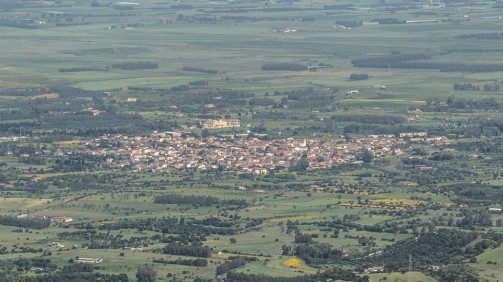The place name comes from the Spanish hermosa and means ‘beautiful and fertile valley,’ in a word ‘laughing.’ Vallermosa, a town populated by about two thousand inhabitants, lies in a valley bounded by two streams at the foot of Mount Cuccurdoni Mannu, on the eastern edge of the Mount Linas massif. It is 15 kilometers from Villacidro, 30 from Iglesias and 35 from Cagliari.
Campidanese clay brick houses with artistic doorways grace the historic districts of Prazz’e cresia, Cruxi santa, Cabina and s’Ecca manna. The parish church of St. Lucifer, dating from the 17th-18th centuries, stands out in the center. In the countryside, you will admire the shrine of St. Mary, near which stand the Roman baths (3rd-4th centuries AD).
Folk festivals are a riot of colors and sounds of traditional clothing and musical rhythms: the patron saint St. Lucifer Bishop is celebrated on May 20, St. Mary’s between Sept. 7 and 9 with a procession from the parish church to the country church and scenic torchlight procession on the way back, and the penultimate weekend in October is the important event “Flavors of Autumn.”
The great naturalistic attraction is the Vallermosese side of the Linas mountain range. Covered by dense forests and furrowed by streams, it has a verdant landscape of ilex groves and various Mediterranean tree species, such as strawberry trees, mastic trees, and wild olive trees. The lush vegetation is home to the Sardinian deer, among others, and you can catch the golden eagle in flight. A network of trails leads into the woods, to be traveled on foot, by bicycle and on horseback.
In the area around Vallermosa, you’ll see lush hills, including the one where Gutturu Mannu (‘big gorge’) Park is located, five kilometers from the town, a large canyon crossed by a stream and covered by hundreds of hectares of forest. It is a popular destination for trekkers, with picnic and rest areas.
You will also be able to discover the life of civilizations of the past in a corner of land where history and nature have met. Four kilometers from the forest you will find the Matzanni archaeological area, which houses a wall structure, three Nuragic well temples surrounded by a village of 13 huts, and the ruins of a Punic temple. The most valuable artifact found is the ‘Beardie’ bronze, which is on display in the National Archaeological Museum in Cagliari. On a hill near the village stands the nuraghe su Casteddu de Fanaris, from which you will admire a striking scenery.
The territory has been inhabited since Nuragic times and then in Punic-Roman times, but the origins of the settlement date back to the mid-17th century, as part of the events of Spanish feudal Sardinia: the Marquis of Villasor, Blasco de Alagòn organized a massive relocation of families to the depopulated villages of Pau Josso and Pau de Vignas.


